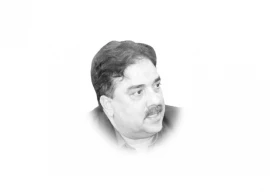
Using hi-tech infrared and radar technology, researchers are trying to unravel the mystery over the legendary monarch's resting place.
A wife of Tutankhamun's father Akhenaten, Nefertiti played a major political and religious role in the 14th century BC, and the discovery of her tomb would be a major prize for Egyptologists.
Egypt's pyramids for grain storage, not pharoahs' tombs: Carson
Experts are now "approximately 90 percent" sure there is a hidden chamber in Tutankhamun's tomb, Antiquities Minister Mamduh al-Damati told a news conference.
The scans were spurred by a study by renowned British archaeologist Nicholas Reeves that said Nefertiti's lost tomb may be hidden in an adjoining chamber.
 The golden mask of Tutankhamun. PHOTO: AFP
The golden mask of Tutankhamun. PHOTO: AFPSpeaking at the same press conference, Reeves said the initial results could bear out his theory.
"Clearly it does look from the radar evidence as if the tomb continues, as I have predicted," he said.
"The radar, behind the north wall (of Tutankhamun's burial chamber) seems pretty clear. If I am right it is a continuation -- corridor continuation -- of the tomb, which will end in another burial chamber," he said.
"It does look indeed as if the tomb of Tutankhamun is a corridor tomb... and it continues beyond the decorated burial chamber," he added.
"I think it is Nefertiti and all the evidence points in that direction."
Cult of sun god
Damati emphasised that the findings were "preliminary" results, and a Japanese expert working with the archaeologists needed a month to analyse the scans.
Experts carried out a preliminary scan of the tomb earlier this month using infra-red thermography to map out the temperature of its walls.
Damati said at that time that the analysis showed "differences in the temperatures registered on different parts of the northern wall" of the tomb.
 A mask of of King Tut is displayed in a glass case at the Valley of the Kings in Luxor, EgyptPHOTO: AFP
A mask of of King Tut is displayed in a glass case at the Valley of the Kings in Luxor, EgyptPHOTO: AFP PHOTO: AFP
PHOTO: AFPBut the minister and Reeves had differed on whose mummy they expected to find.
According to Reeves, professor of archaeology at the University of Arizona, Tutankhamun, who died unexpectedly, was buried hurriedly in an underground chamber probably not intended for him.
The boy king died aged 19 in 1324 BC after just nine years on the throne. His final resting place was discovered by another British Egyptologist, Howard Carter, in 1922.
 The tomb of King Tut is displayed in a glass case at the Valley of the Kings in Luxor, Egypt, Tuesday. On Saturday, Nov. 28, 2015. PHOTO: AFP
The tomb of King Tut is displayed in a glass case at the Valley of the Kings in Luxor, Egypt, Tuesday. On Saturday, Nov. 28, 2015. PHOTO: AFPReeves's theory is that priests would have been forced to reopen Nefertiti's tomb 10 years after her death because the young pharaoh's own mausoleum had not yet been built.
But Damati believes that such a chamber, if found adjoining Tutankhamun's tomb, may contain Kiya, another of Akhenaten's wives.
Akhenaten is known for having temporarily converted ancient Egypt to monotheism by imposing the cult of sun god Aton.
Nefertiti's role in the cult would have ruled out her burial in the Valley of the Kings according to Zahi Hawass, the country's former antiquities minister and expert on ancient Egypt.
"Nefertiti will never be buried in the Valley of the Kings," he told AFP.
"The lady was worshipping Aton with Akhenaten for years. The priests would never allow her to be buried in the Valley of the Kings," he said.
Hawass also questioned how archaeologists would enter the hidden part of the tomb without causing damage.
Damati said that after the analysis, that would be the next challenge.
"The data is being analysed to get a clear picture of what's behind the wall," he said.
"The next step, which we will announce once we agree on it, will be accessing what's behind the wall without damaging the tomb," he said.







1724994274-0/BeFunky-(12)1724994274-0-270x192.webp)







1736844405-0/Express-Tribune-(2)1736844405-0-270x192.webp)







COMMENTS (1)
Comments are moderated and generally will be posted if they are on-topic and not abusive.
For more information, please see our Comments FAQ